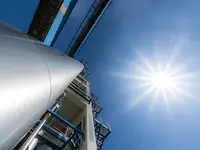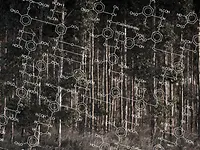Join us on a journey to tomorrow - transform your pulp mill into a full-scale biorefinery.
Raw material efficiency
Optimize raw material utilization. Increase yield and resource reuse while ensuring long-term sustainability and profitability. Our proven solutions for water, wood, chemicals, and evolving raw material sources help you optimize every step of the process. Partner with us to unlock new opportunities and drive efficiency across your operations.

Bracell – A-ConFlex™ continuous kraft and dissolving pulping; multiple world records at pulp drying plant. World’s largest recovery boiler powers the mill and exports approximately 180 MW to Brazilian grid. Largest NCG treatment system globally with focus on side streams recovery.
For ANDRITZ, self-sufficiency in energy and chemicals means optimizing our customers’ processes to generate sufficient energy and recover essential chemicals internally—minimizing reliance on external inputs and supporting more sustainable, cost-efficient operations.
This involves using technologies like recovery boilers to maximize energy production from residual materials, efficient white liquor plants to recycle cooking chemicals, and evaporation plants to produce clean condensates. Optimizing and fine-tuning these systems and processes can lead to significant process improvements and manpower savings.
The ARC (Ash Re-Crystallization) and ALE (Ash Leaching) systems support chemical self-sufficiency in pulp mills by removing non-process elements such as chloride and potassium from ElectroStatic Precipitator (ESP) ash and returning valuable chemicals to the chemical recovery cycle. These systems enhance the efficiency of the chemical recovery process while consuming a minimum amount of energy.
The SulfoLoop sulfuric acid plant not only supports fully closed loop sulfidity control and self-sufficiency in sulfuric acid, but also helps unlock the full potential of pulp mills by transforming unused side streams into valuable bioproducts. This integrated approach leads to cost savings and generates additional revenue through the production of value-added products.
Wood processing plays a vital role in reducing environmental impact. Efficient wood processing minimizes wood losses, which can lead to substantial raw material savings and improved fiber yield.
The optimization of wood processing begins in the log yard. Our Autonomous Logyard Crane is designed to enhance raw material efficiency in wood processing facilities. These electric-driven cranes reduce operating costs by up to 50% and eliminate the need for diesel fuel. When equipped with ANDI – the crane AI, ANDRITZ cranes provide real-time tracking and classification of wood, ensuring optimal use of resources through automated inventory management.
In cold climates, steam deicing in debarking drum can significantly lower the freshwater usage compared to traditional hot water deicing on the infeed conveyor. With a much smaller footprint, less water and energy use, and improved efficiency when it comes to wood losses, steam deicing technology from ANDRITZ represents important benefits to pulp mill operators when deicing logs.
ANDRITZ chipping technologies, such as the HHQ-Chipper equipped with the ANDRITZ knife system, are designed to produce high and uniform chip quality for the cooking process, resulting in significant savings in raw material, better yield in pulping, increased pulp production, lower chemical consumption, and higher pulp strength.
Intelligent wood yard products like Smart LogSCAN, Smart BarkSCAN, and Smart ChipSCAN optimize the debarking and chipping processes, ensuring better raw material utilization and delivering higher and more consistent chip quality to the cooking process.
ANDRITZ cooking technologies are designed to enhance raw material efficiency in pulp production by reducing wood and water usage, minimizing energy consumption, and optimizing the overall process.
LoSolids cooking technology allows for more homogeneous cooking by ensuring better liquor mixing with the chips. This results in a more stable cooking process, leading to higher pulp yield and better pulp quality. Washing in the digester results in a more efficient brownstock washing stage, reducing the need for additional chemicals and water later in the pulping process.
A-ConFlex™ flexible continuous kraft and dissolving pulping technology enhances raw material efficiency by allowing seamless switching between high-quality dissolving pulp and paper-grade pulp production, optimizing the use of raw materials based on market demand. It enables the extraction and refining of hydrolysate into valuable bio-products, ensuring all components of the raw materials are utilized effectively. The technology also achieves high fiber yields due to its excellent selectivity and controlled recovery of by-products, while reducing operational costs by being retrofittable to existing installations.
The A-ConApex™ cooking technology is a fully independent continuous cooking system designed to enhance raw material efficiency by processing and utilizing almost any type of cellulosic raw material, including fines from chip screening, screen room rejects, cotton textile waste, agricultural waste, and sawdust. When installed alongside a kraft pulp digester, it adds to the mill's overall production capacity and helps in reducing waste.
Optimizing raw water and wood usage, energy and chemical consumption, and water recirculation within the fiberline significantly enhances ANDRITZ fiberline's raw material efficiency. By reducing raw water usage and increasing the recirculation of treated effluent, water consumption and associated energy costs are lowered, minimizing environmental impact.
Implementing energy-efficient technologies and optimizing processes like brownstock washing and oxygen delignification reduce energy usage, lowering operational costs and enhancing sustainability. Optimizing chemical usage in bleaching and delignification reduces chemical needs while maintaining pulp quality, leading to cost savings and a smaller environmental footprint.
Recirculating water and reusing recovered condensates—from processes such as cooking or pulp drying, via the evaporation plant—within the fiberline significantly reduces the need for fresh water and lowers effluent volumes. At the same time, the DEvap digester evaporator enables the use of secondary steam instead of fresh steam in various fiberline positions, reducing overall steam demand. These optimizations improve raw material efficiency, reduce operational costs, and enhance environmental performance—advancing the mill toward a closed-loop system and making ANDRITZ fiberlines more competitive and sustainable.
High Kappa pulping is a process that combines chemical and mechanical treatments to produce pulp with high stiffness and well-bonded fibers. This type of pulp is ideal for various applications, including kraftliner production. ANDRITZ has successfully converted several paper-grade pulp lines to produce high Kappa pulp, utilizing mainly existing equipment. This approach not only extends the lifespan of mills but also opens up new market opportunities for their products.
Maintenance and support services are essential for maximizing raw material efficiency. By proactively addressing potential issues and ensuring equipment operates at peak performance, our customers can significantly reduce waste and optimize the use of raw materials.This not only leads to cost savings but also enhances overall operational efficiency.
Well-maintained equipment consumes less energy and resources, extends its lifespan, and maintains high productivity levels, all of which contribute to more sustainable and efficient use of raw materials.

Suzano’s Ribas do Rio Pardo mill in Brazil, the world’s largest single-line eucalyptus pulp mill, reached design capacity in just 87 days. With an annual capacity of 2.55 million tonnes, it features the ANDRITZ SulfoLoop plant that recycles sulfur from waste gases into commercial-grade sulfuric acid.





